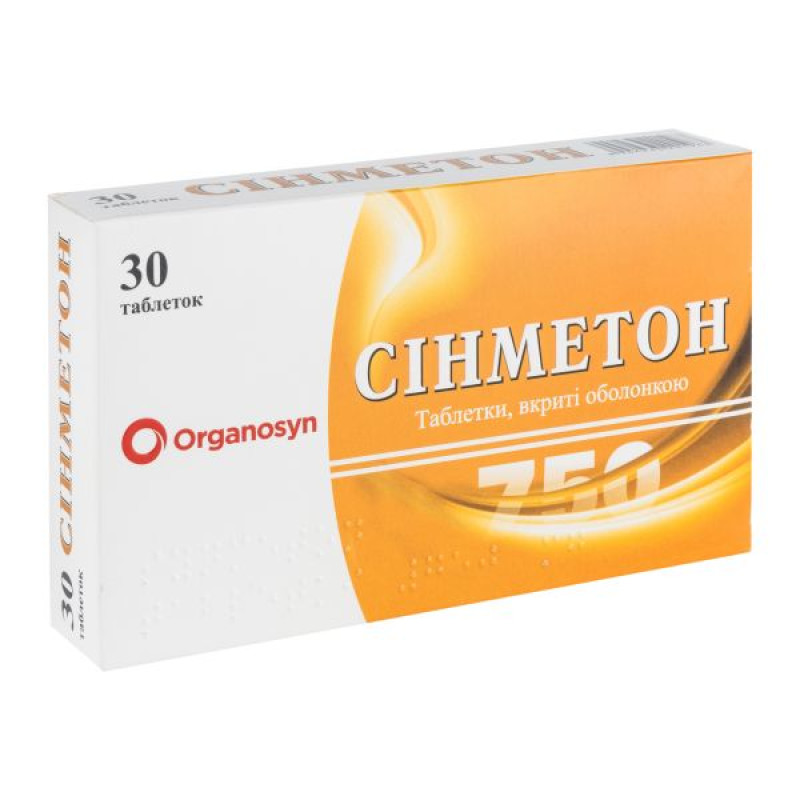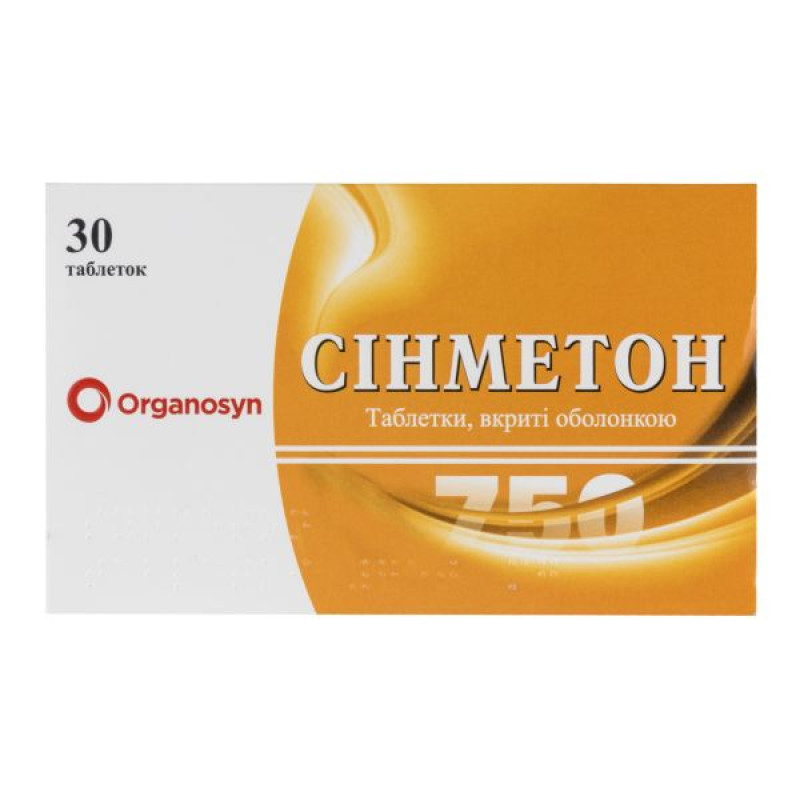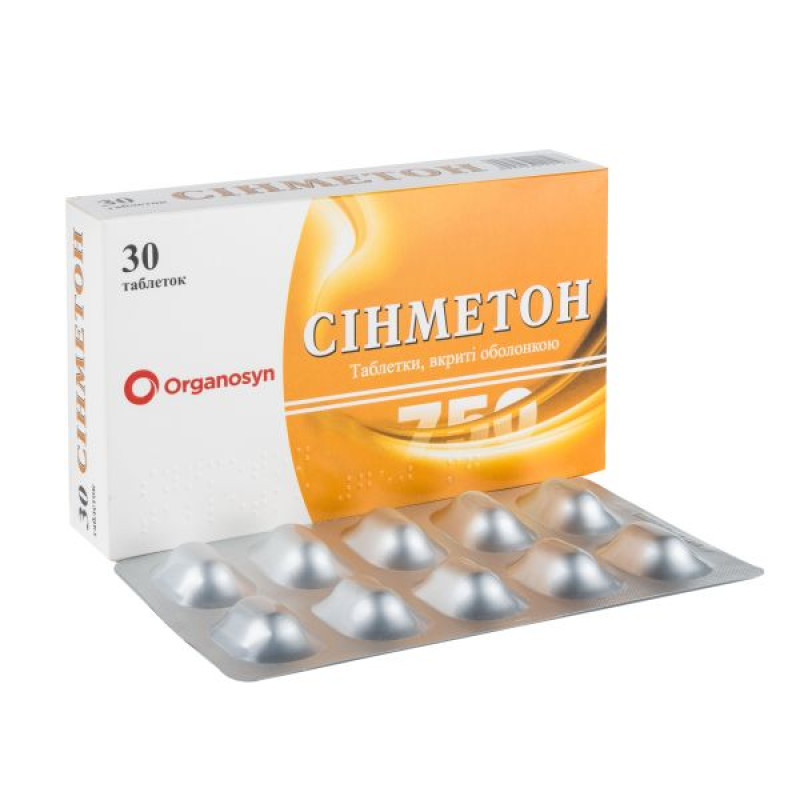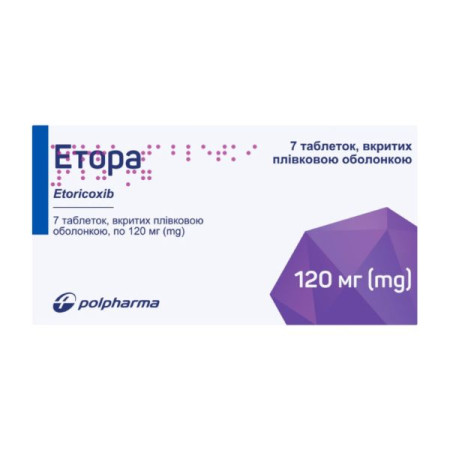Sinmeton film-coated tablets 750 mg blister No. 30

Instructions for Sinmeton film-coated tablets 750 mg blister No. 30
Composition
active ingredient: nabumetone;
1 tablet contains: nabumetone 750 mg;
excipients: microcrystalline cellulose, corn starch, polysorbate 80, sodium lauryl sulfate, sodium starch glycolate (type A), colloidal anhydrous silica, talc, hypromellose, titanium dioxide (E 171), polyethylene glycol 6000, red iron oxide (E 172).
Dosage form
Film-coated tablets.
Main physicochemical properties:
Sinmeton 750 mg: reddish-brown, oval-shaped, biconvex, scored, film-coated tablets.
Pharmacotherapeutic group
Drugs affecting the musculoskeletal system. Nonsteroidal anti-inflammatory and antirheumatic drugs. Nabumetone. ATX code M01A X01.
Pharmacological properties
Pharmacodynamics
The active substance of the drug - nabumetone - belongs to the alkanones, and is a non-acidic non-steroidal anti-inflammatory drug (NSAID), which after absorption from the gastrointestinal tract is rapidly metabolized in the liver to the main active metabolite - 6-methoxy-2-naphthylacetic acid (6-MNA). It has anti-inflammatory, antipyretic, analgesic effects. The mechanism of action is associated with the blockade of cyclooxygenase-2 (COX-2), which leads to impaired metabolism of arachidonic acid and a decrease in the concentration of prostaglandins, thromboxanes. It suppresses exudative and proliferative processes in the focus of inflammation, reduces the concentration of bradykinin and histamine, and also increases the threshold of sensitivity of pain receptors. The hypothermic effect is due to a decrease in the concentration of pyrogens in the cerebrospinal fluid and hypothalamic zone, an increase in heat loss (it does not affect heat production).
Since nabumetone exhibits moderate selectivity for inhibition of mainly COX-2, a characteristic feature of nabumetone is the lack of effect on the gastric mucosa. A lower incidence of ulceration, bleeding and perforation has been reported compared with other NSAIDs. It has little effect on collagen-induced platelet aggregation and has no effect on bleeding time.
Pharmacokinetics
After oral administration, nabumetone is rapidly absorbed from the gastrointestinal tract (>80%), food or milk accelerate its absorption. It is metabolized in the liver with the formation of the active metabolite (6-MNK) - up to 35% of the dose taken and other unidentified metabolites (50%).
The maximum concentration of the active metabolite is reached after approximately 3 hours (range 1–12 hours), the protein binding is 99%, penetrates the placental barrier and into breast milk. Due to its strong protein binding, 6-MNA cannot be removed by hemodialysis.
The active metabolite undergoes further metabolism in the liver by conjugation with glucuronic acid and o-demethylation before being excreted mainly in the urine.
About 75% of the nabumetone dose is excreted by the kidneys. The half-life is 24 hours.
The plasma half-life of 6-MNA varies considerably (mean values in young patients range from approximately 22 to 27 hours and 25 to 34 hours in elderly patients).
Elderly patients
Steady-state plasma concentrations are generally higher and the half-life is longer (29.8 ± 8.1 hours) in elderly subjects than in young healthy subjects, but the differences are unlikely.
Patients with renal insufficiency
In patients with severe renal impairment (creatinine clearance <30 ml/min), the mean half-life of 6-MNC was increased to approximately 40 hours, and plasma levels were 30% higher than in other patients. In patients undergoing hemodialysis, steady-state plasma concentrations of the active metabolite were equivalent to those observed in healthy subjects.
Indication
For the treatment of pain and inflammation in osteoarthritis and rheumatoid arthritis.
Contraindication
hypersensitivity to the active substance or to other components of the drug; hypersensitivity in history (e.g. bronchial asthma, angioedema, urticaria, rhinitis), allergic reactions associated with the use of acetylsalicylic acid or other non-steroidal anti-inflammatory drugs; active ulcer or history of recurrence of peptic ulcer (2 or more episodes of gastrointestinal bleeding, perforation) or peptic ulcer disease; gastrointestinal bleeding or perforation in history associated with the use of non-steroidal anti-inflammatory drugs; severe cardiac and/or hepatic and/or renal failure; the period after coronary artery bypass grafting (CABG); cerebrovascular or other active form of bleeding, hemorrhagic diathesis; third trimester of pregnancy; breastfeeding period; children's age (up to 18 years).
Interaction with other medicinal products and other types of interactions
with anticoagulants - increased effectiveness of the latter; drugs should be used with caution and symptoms of anticoagulant overdose should be monitored; with antihypertensive agents (e.g., angiotensin-converting enzyme (ACE) inhibitors, angiotensin receptor antagonists (ARA)), diuretics - decreased effectiveness of the latter; in some patients with impaired renal function (e.g., elderly or dehydrated patients), simultaneous administration of ACE inhibitors and angiotensin II receptor antagonists with cyclooxygenase inhibitors may lead to additional deterioration of renal function, including the possibility of acute renal failure; with simultaneous use of drugs, frequent monitoring of the patient's condition should be carried out; patients should receive sufficient fluid; with antiplatelet agents, selective serotonin reuptake inhibitors, corticosteroids - increased risk of gastrointestinal bleeding; with other nonsteroidal anti-inflammatory drugs, including selective cyclooxygenase-2 inhibitors - increased risk of adverse reactions; simultaneous use of these drugs should be avoided; with zidovudine - increased risk of hematotoxicity; an increased risk of hemarthrosis and hematomas has been reported in HIV-positive patients suffering from hemophilia with simultaneous use of these drugs; with potassium-sparing diuretics - risk of hyperkalemia; with lithium, methotrexate - decreased excretion of the latter; with mifepristone - weakening of the latter's effect; nonsteroidal anti-inflammatory drugs should be used 8-12 days after taking mifepristone; with cardiac glycosides - increased heart failure, decreased glomerular filtration rate and increased plasma glycoside levels; with cyclosporine, tacrolimus - increased risk of nephrotoxicity; with quinolones - increased risk of seizures; with cholestyramine – slowing down the absorption of nabumetone.
Drugs that do not affect the metabolism and bioavailability of nabumetone: antacids, paracetamol, cimetidine, aluminum hydroxide, acetylsalicylic acid.
Nabumetone should be used with caution concomitantly with protein-binding drugs such as sulfonamides, sulfonylureas, hydantoins, and symptoms of overdose should be monitored.
Application features
Adverse drug reactions can be minimized by using the lowest effective dose for the shortest duration of treatment necessary to control symptoms.
Concomitant use with other medications.
Concomitant use of the drug with other nonsteroidal anti-inflammatory drugs (including selective COX-2 inhibitors) should be avoided.
Impact on elderly patients.
Elderly patients are at increased risk of developing adverse reactions, especially gastrointestinal bleeding and perforation, which can be fatal.
Impact on patients suffering from bronchial asthma.
The drug should be used with caution in patients with a history of acetylsalicylic acid or other NSAIDs-induced asthma, urticaria or other allergic-type reactions, since bronchospasm with fatal asthma attacks has been reported in these categories of patients with the use of other nonsteroidal anti-inflammatory drugs. The first use of nabumetone in patients suffering from bronchial asthma should be under medical supervision.
Effect on the organs of vision.
Visual disturbances and decreased visual acuity have been reported with the use of nonsteroidal anti-inflammatory drugs, including nabumetone. If these disturbances develop, patients should undergo an ophthalmological examination.
Effects on the reproductive system.
The use of nonsteroidal anti-inflammatory drugs, including nabumetone, may impair female fertility. The drug is not recommended for use in women attempting to conceive. Discontinuation of the drug should be considered in women undergoing investigation of infertility or experiencing difficulties conceiving.
Effect on the digestive tract.
Gastrointestinal bleeding, ulceration and perforation, which can be fatal, have been reported with all NSAIDs at any time during treatment, with or without previous symptoms or a history of serious gastrointestinal disease.
Patients with a history of peptic ulcer disease (especially the elderly) should be informed of any unusual abdominal symptoms, which is especially important in the initial stages of treatment.
For these patients, combination therapy with gastroprotective agents (such as misoprostol or proton pump inhibitors) should be considered, as well as for patients requiring concomitant therapy with low-dose acetylsalicylic acid or other drugs that increase gastrointestinal risk.
Patients should be advised to report any unusual abdominal symptoms, particularly during the initial stages of treatment. Caution should be exercised in patients with a history of gastrointestinal disease (e.g. ulcerative colitis or Crohn's disease) as these conditions may be exacerbated.
The drug should be used with caution in concomitant therapy with drugs that increase the risk of ulcers or bleeding, such as oral contraceptives, anticoagulants (warfarin), nonsteroidal anti-inflammatory drugs, selective serotonin reuptake inhibitors, antiplatelet agents (acetylsalicylic acid, clopidogrel). In the event of ulceration or bleeding, the drug should be discontinued.
The drug should be used only after a careful assessment of the benefit/risk ratio in patients with active peptic ulcer disease. Patients should be under close medical supervision.
Nabumetone is better tolerated than most other NSAIDs, including less gastrointestinal adverse effects. Pre- and post-marketing studies have shown that the average incidence of perforation, ulceration, and bleeding is lower with nabumetone than with other NSAIDs: 0.3%, 0.5%, and 0.8% for 3 to 6 months, 1 year, and 2 years of therapy, respectively. However, physicians should be aware that ulcers can occur without a history of ulceration.
Despite its relative safety for the digestive tract and kidneys, the drug should be used with caution in patients with:
with active gastrointestinal ulceration; appropriate treatment should be initiated before nabumetone therapy; with bronchial asthma, urticaria, or other hypersensitivity reactions associated with the use of nonsteroidal anti-inflammatory drugs; the development of asthma with a fatal outcome has been rarely reported in such patients; the drug should be used under medical supervision.
Effects on the skin and subcutaneous tissue.
Serious skin reactions, including exfoliative dermatitis, Stevens-Johnson syndrome, toxic epidermal necrolysis and drug reaction with eosinophilia and systemic symptoms (DRESS), which can be fatal, have been reported rarely with the use of NSAIDs, including nabumetone. The risk of these events is highest early in treatment, most often within the first two months of therapy. If skin rash, mucosal lesions or any other sign of hypersensitivity occurs, the drug should be discontinued immediately and alternative treatments considered.
If you develop a widespread rash, high body temperature, elevated liver enzymes, changes in blood counts (eosinophilia), enlarged lymph nodes involving other organs of the body (drug reaction with eosinophilia and systemic symptoms, known as hypersensitivity syndrome, or DRESS), stop using SINMETON, tell your doctor and/or seek emergency medical attention.
Early administration of systemic steroids is usually recommended for all cases of DRESS syndrome. In the treatment of DRESS syndrome, most patients recover completely after drug withdrawal and appropriate therapy, but chronic complications and fatal outcomes due to irreversible damage to individual internal organs cannot be ruled out.
Patients who have previously experienced serious adverse reactions such as Stevens-Johnson syndrome, toxic epidermal necrolysis, reactions with eosinophilia and systemic symptoms associated with nabumetone should never be re-administered with nabumetone.
Effect on the cardiovascular system.
The use of some non-steroidal anti-inflammatory drugs (especially at high doses and over a long period) may lead to an increased risk of arterial thrombotic complications (such as myocardial infarction or stroke). Since there are insufficient data to exclude such a risk for nabumetone, the drug should be used only after careful assessment and under medical supervision in patients with arterial hypertension, mild or moderate congestive heart failure, diagnosed ischemic heart disease, peripheral arterial disease and/or cerebrovascular disease and, in the case of long-term therapy, in patients with risk factors for cardiovascular disease such as hypertension, hyperlipidemia, diabetes mellitus, smoking. Patients with a history of arterial hypertension and mild to moderate congestive heart failure should be periodically monitored and advice given as necessary, as fluid retention and edema have been reported.
Hepatic dysfunction and, in rare cases, jaundice and hepatic failure, which in some cases may be fatal, have been reported with the use of nonsteroidal anti-inflammatory drugs, including nabumetone. If signs/symptoms of hepatic dysfunction or elevations of hepatic transaminases occur, the patient should be closely monitored for more serious events and the drug discontinued if necessary.
Effect on the urinary system.
The use of nonsteroidal anti-inflammatory drugs leads to a dose-dependent decrease in prostaglandin synthesis, which leads to a decrease in glomerular filtration and may cause the development of renal failure. The drug should be used with caution in patients with risk factors such as impaired renal and/or liver function, heart failure, concomitant use of diuretics, and elderly age. In patients with moderate renal failure (creatinine clearance from 30 to 49 ml/min), a 50% increase in the level of unbound 6-MNC in the blood plasma was determined, and a dose reduction may be justified for them.
Renal function should be monitored by measuring creatinine clearance at baseline and for several weeks after initiation of therapy. If renal function deteriorates, discontinuation of therapy may be warranted.
Aseptic meningitis has been reported in isolated cases in patients receiving nabumetone. Although this reaction is more likely to occur in patients with systemic lupus erythematosus and other connective tissue diseases, it has also been reported in patients without underlying chronic diseases.
The use of nonsteroidal anti-inflammatory drugs, including nabumetone, may mask the symptoms of infectious diseases.
Ability to influence reaction speed when driving vehicles or other mechanisms
During the use of the drug, side effects such as dizziness, drowsiness, confusion, fatigue, visual impairment may occur. In the event of these side effects, you should refrain from driving or using other mechanisms.
Use during pregnancy or breastfeeding
Pregnancy period.
There is no clinical experience with the use of nabumetone during pregnancy.
Inhibition of prostaglandin synthesis may adversely affect pregnancy and/or embryo-fetal development. Epidemiological studies have shown an increased risk of miscarriage, heart defects and gastroschisis after use of a prostaglandin synthesis inhibitor in early pregnancy. The absolute risk of cardiovascular malformation has been shown to increase from less than 1% to approximately 1.5%. The risk is believed to increase with dose and duration of therapy. Use of the drug during the first and second trimesters of pregnancy is possible if the potential benefit to the mother outweighs the potential risk to the fetus.
If nabumetone is used by a woman attempting to conceive, or during the first and second trimesters of pregnancy, the dose should be kept as low as possible and the duration of treatment should be as short as possible.
During the third trimester of pregnancy, all prostaglandin synthesis inhibitors may adversely affect the fetus:
cardiopulmonary toxicity (with premature closure of the fetal ductus arteriosus and pulmonary hypertension); renal dysfunction, which may progress to renal failure with oligohydramnios;
Affect the mother and fetus simultaneously:
Possible prolongation of bleeding time, antiplatelet effect, which may occur even at very low doses; suppression of uterine contractions, leading to delayed or prolonged labor.
Therefore, the drug is contraindicated for use in the third trimester of pregnancy.
Breastfeeding period.
The excretion of nabumetone into breast milk has not been studied. Breastfeeding should be discontinued if the drug is used.
Method of administration and doses
The drug should be administered orally to adults during or after meals.
The recommended initial dose is 500-750 mg once daily. The recommended daily dose is 1 g once daily at bedtime. In cases of severe or persistent symptoms, the dose may be increased to 1.5-2 g daily by adding one or two tablets (500 mg-1 g) as a morning dose. The maximum daily dose is 2 g.
The drug should be used for the shortest time at the lowest effective dose necessary to control the symptoms of the underlying disease.
The duration of the treatment course is determined by the doctor individually depending on the achieved effect, the nature of the therapy, and the tolerability of the drug.
Elderly patients
In elderly patients, the drug may remain in the blood longer and the drug level may be higher, so the recommended daily dose of 1 g should not be exceeded, and in some cases one tablet (500 mg) may provide satisfactory relief.
Children
The drug is not recommended for use in pediatric practice, as the safety and efficacy of nabumetone in children have not been established.
Overdose
Symptoms: headache, nausea, vomiting, epigastric pain, gastrointestinal bleeding, diarrhea, disorientation, agitation, coma, drowsiness, dizziness, tinnitus, fainting, convulsions; in case of severe poisoning, acute renal failure and liver damage are possible.
Treatment. There is no specific antidote and the active metabolite 6-MNK is not removed by hemodialysis. In case of acute overdose, gastric lavage should be performed within the first hour after overdose, activated charcoal should be administered orally up to 60 g, which can effectively reduce the absorption of nabumetone (a decrease of up to 80% of the maximum plasma concentrations of the active metabolite was determined); forced diuresis should be performed, further therapy is symptomatic. Liver and kidney function should be carefully monitored. The patient should be closely monitored for at least 4 hours after overdose.
Adverse reactions
From the blood and lymphatic system: thrombocytopenia, leukopenia, agranulocytosis, granulocytopenia, neutropenia, aplastic anemia, hemolytic anemia.
Immune system disorders: hypersensitivity reactions, including anaphylactic shock, anaphylactoid reactions.
On the part of the psyche: confusion, nervousness, insomnia, depression, hallucinations.
Nervous system: drowsiness, dizziness, headache, paresthesia, agitation, aseptic meningitis.
From the organs of vision: visual impairment, optic neuritis.
From the side of the organs of hearing and vestibular apparatus: tinnitus, hearing impairment.
Cardiovascular system: heart failure, arrhythmias, hypertension, hypotension, edema, vasculitis.
Respiratory, thoracic and mediastinal disorders: dyspnea, respiratory distress, epistaxis, interstitial pneumonitis, asthma, exacerbation of asthma, bronchospasm.
From the digestive tract: diarrhea, constipation, dyspepsia, gastritis, nausea, abdominal pain, flatulence, ulcers of the digestive tract mucosa, gastrointestinal bleeding, exacerbation of ulcerative colitis and Crohn's disease, gastrointestinal disorders, melena, vomiting, heartburn, stomatitis, dry mouth, pancreatitis.
From the hepatobiliary system: liver failure, jaundice, bitterness in the mouth.
From the urinary system: renal failure, nephrotic syndrome, interstitial nephritis, dysuria.
Musculoskeletal and connective tissue disorders: myopathy.
Skin and subcutaneous tissue disorders: rash, itching, photosensitivity, urticaria, increased sweating, bullous reactions including toxic epidermal necrolysis, Stevens-Johnson syndrome, drug hypersensitivity syndrome with eosinophilia and systemic symptoms (DRESS syndrome), erythema multiforme, angioedema, pseudoporphyria, alopecia, purpura.
From the reproductive system and mammary glands: metrorrhagia.
General disorders: edema, asthenia, fatigue, malaise.
Results of laboratory and instrumental studies: increased levels of hepatic transaminases, hematuria, crystalluria, albuminuria, azotemia.
Results of clinical and epidemiological studies suggest that the use of some nonsteroidal anti-inflammatory drugs may be associated with an increased risk of arterial thrombotic complications (e.g. myocardial infarction or stroke).
Expiration date
2 years.
Storage conditions
Store at a temperature not exceeding 25 ° C. Keep out of the reach of children.
Packaging
10 tablets in a blister, 3 blisters in a cardboard pack.
Vacation category
According to the recipe.
Producer
Evertogen Life Sciences Limited.
Location of the manufacturer and its business address
Plot No.: S-8, S-9, S-13/P and S-14/P T E C I A C, S I Z Pharma, Green Industrial Park, Polepally (V), Yedcherla (M), Mahabubnagar, Telangana, IH-509 301, India.
There are no reviews for this product.
There are no reviews for this product, be the first to leave your review.
No questions about this product, be the first and ask your question.











